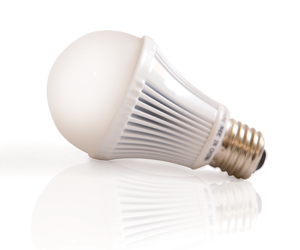This is the last Lightfair before new regulations governing lightbulb efficiency begin to take effect in the US in January, and there’s a real sense of history and urgency on the show floor. Ready or not, the way we light our homes and offices is about to change, and the technology that will lead the way is somewhere in this hall. The selection of LED replacement lamps for interior use continues to grow and expand.
 If all goes according to plan, the provisions of 2007’s Energy Independence and Security Act will effectively ban 100-watt incandescents starting in 2012. Seventy-five-watt bulbs will depart in 2013, followed by 60- and 40-watt lamps a year later. So the race to find a suitable replacement technology is coming down to the wire. The industry is banking on LED lighting as the way forward, and it’s virtually the only bulb technology on display: There is barely a single incandescent or sickly compact fluorescent to be seen. Just 200,000 square feet of companies racing to fill their share of the world’s billions of standard sockets—and betting on LEDs as the way to do it.
If all goes according to plan, the provisions of 2007’s Energy Independence and Security Act will effectively ban 100-watt incandescents starting in 2012. Seventy-five-watt bulbs will depart in 2013, followed by 60- and 40-watt lamps a year later. So the race to find a suitable replacement technology is coming down to the wire. The industry is banking on LED lighting as the way forward, and it’s virtually the only bulb technology on display: There is barely a single incandescent or sickly compact fluorescent to be seen. Just 200,000 square feet of companies racing to fill their share of the world’s billions of standard sockets—and betting on LEDs as the way to do it.
There’s an excellent reason LEDs have taken on the aura of inevitability: LEDs are semiconductors, and like all solid-state technology, they are getting better and cheaper on a predictable curve. In 1999, a researcher named Roland Haitz, then heading up semiconductor R&D at Hewlett-Packard, coauthored a paper that became the lighting industry’s manifesto. By charting the historical prices of LEDs and projecting forward, Haitz estimated that the amount of light they produced would increase by a factor of 20 per decade, while the cost would correspondingly drop by a factor of 10.
Haitz’s law has proven remarkably accurate. But the lighting industry still has major hurdles to clear before LEDs gain acceptance by consumers. Beyond the very real technical issues—cooling, costs, light color—there’s the public’s lingering distaste for compact fluorescent lamps, which failed miserably in their projected role as bulb of the future. That sentiment has fed into a Tea Party-fueled backlash against the new regulations, and there have been attempts in Congress to roll them back entirely.
The reasoning behind the lighting provisions in the Energy Independence and Security Act is pretty straightforward: Incandescents convert less than 10 percent of the energy pumped into them into light, losing the rest as heat. More-efficient bulbs could save billions of dollars, decrease dependence on foreign oil, and significantly reduce greenhouse gases.
Still, the consumer backlash resonates, and not simply because CFLs are horrible, flickery, ugly, and unreliable. Evolutionary biologists believe that human lighting preferences are the result of our trichromatic vision—rare in nonprimates—which makes us particularly suited to daylight and the perception of primary colors. There’s an anthropological component as well: For 400,000 years, humankind has been banishing darkness with fire. And Edison’s bulb is, at its core, a burning filament that casts the glow of a flame. Abandoning incandescent bulbs means abandoning fire as our primary light source for the first time in human history.
Though there are countless 60-watt LED prototypes in evidence at Lightfair, few are available for side-by-side comparisons with incandescents. Most are sealed inside display cases or exist only in press releases or PowerPoint presentations. The Switch bulbs are out in the open: crystalline shells of clear, faceted glass, with aluminum prongs holding yellow-tinted LEDs that shine through the cooling liquid to cast a warm, living-room-quality glow—and draw only 13 watts to do it.
About 80 percent of all bulbs sold in the US are rated at or equivalent to 60, 75, or 100 watts, but nearly every LED brought to market so far has come in the 40-watt-equivalency range, good for little beyond closets and crawl spaces. Brighter bulbs are either too hot, too expensive (upwards of $50, though they can last for 20 years), or both. Switch plans to start selling its 60-watt-equivalent bulb this fall for around $30.
By Dan Koeppel. Read the entire article
Buy Direct and Save $$$ – All of our lighting fixtures ship factory direct to your facility. Call sales toll-free (1-844-533-7767).
Filed under: LED Lighting







